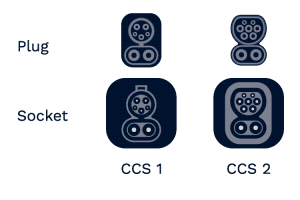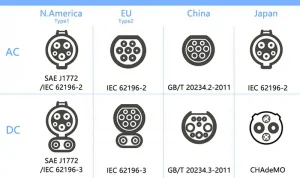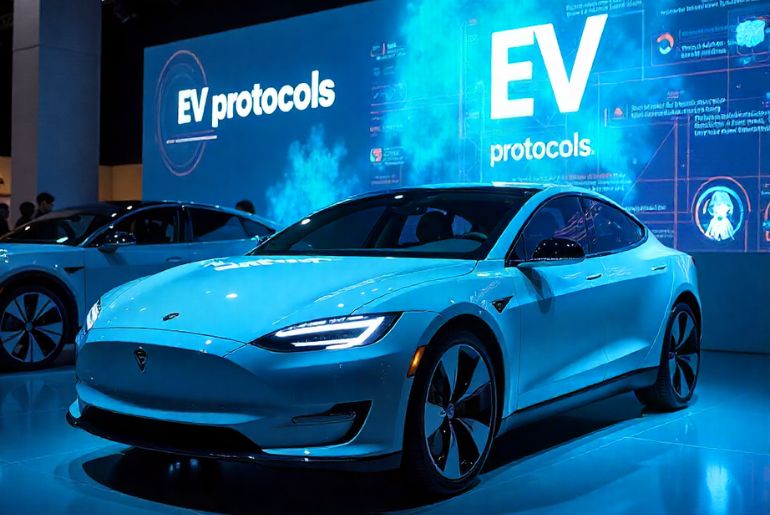As electric vehicles (EVs) continue to change the transportation landscape globally, their success is based on the right charging systems that are effective, safe, and have compatibility. Within the growing ecosystem of EVs, the central part of that ecosystem consists of EV charging standards. EV charging standards define the technical protocols, power levels, type of connectors and methods of communication that are used to charge an EV in varied geographic locations, effectively and safely. These standards are necessary to promote compatibility between EVs and charging systems, promote charging networks to minimize range anxiety, and ultimately promote the mass adoption of EVs. For manufacturers, fleet managers, policymakers, charging infrastructure providers and the general public, understanding the complexities of EV charging standards to make informed investing decisions, design future-proofed products or systems, and importantly support seamless electric mobility.
What, exactly, are EV Charging Standards?
The Electric Vehicle (EV) charging standards are a set of technical specifications, which define how an EV and a charging station interacts. They define:
- Types of connectors (plugs and jacks)
- Charging modes (AC or DC)
- Vehicle to charging Equipment communication protocols
- Safety requirements
- Power transfer and voltage requirements
These charging standards ensure that EVs from different manufacturers can be safely charged at varying public and private charging sites.
Global Charging Standards
The electric vehicle industry shares a number of globally recognized EV charging standards across the globe:
1. AC Charging
Type 1 (SAE J1772) – Prevalent in the North America and Japan.
Type 2 (IEC 62196-2) – A standard used across Europe, commonly known as Mennekes.
2. DC Fast Charging
CCS (Combined Charging System)
CCS1: North America
CCS2: Europe and the vast majority of the rest of the world

CHAdeMO:
Originally developed in Japan
Usage is still present for now but is declining around the world
GB/T:
China’s national standard for AC and DC charging
NACS (Tesla):
Tesla’s proprietary connector in North America that other manufacturers like Ford and GM are utilizing.
Each of these standards helps define compatibility between networks, as well as assist with infrastructure expansion around the world.

Charging Standards Specific to India
India has chosen to create its own EV charging standards to meet local needs but remain globally aligned.
1. Bharat Electric Vehicle Specifications
Bharat Electric Vehicle Standards are a set of technical specifications put forth by the Indian Government to address EV charging networks for India’s unique vehicle diversity, power conditions, and affordability. These specifications were developed by the Ministry of Heavy Industries (MHI) and the Department of Heavy Industry (DHI), and are aligned with policies around EV’s in India such as FAME II (Faster Adoption and Manufacturing of Hybrid and Electric Vehicles).
a. Bharat AC001
- Type: Slow charging standard (AC)
- Output: 3.3 kW per connector (3 connectors per unit)
- Voltage: 230V, single-phase
- Target vehicles: Mainly electric two-wheelers and three-wheelers
- Features: RFID authentication, CAN communication, affordable deployment
- Use case: Public charging, low-cost fleet charging
b. Bharat DC001
- Type: Fast charging standard (DC)
- Output: Up to 15 kW (72–200V DC, 120A)
- Target vehicles: E-rickshaws, electric three-wheelers, and small EVs
- Connector: Custom-designed DC connector (not CHAdeMO or CCS)
- Features: Cost-effective for Indian grid constraints
2. Global Compatibility
To facilitate growth in the passenger car and commercial EV market, India also encourages globally accepted EV charging standards:
- CCS2: Mandated for high-voltage fast charging of four-wheelers
- CHAdeMO: Supported for legacy compatibility
- Type 2 AC: For Level 2 charging
The Ministry of Power has published guidelines allowing chargers supporting multiple protocols to ensure interoperability.
Communication Protocols: The Digital Backbone
EVs and chargers communicate using software protocols. The key ones include:
- IEC 61851: Governs general EV conductive charging system
- IEC 62196: Specifies connector configuration
- ISO 15118: Enables Plug & Charge and V2G (Vehicle-to-Grid) capabilities
These protocols allow real-time data exchange on power demand, battery state, authentication, and billing.
Why Are Charging Standards Important?
Charging standards are important for a variety of reasons for different stakeholder interests.
- OEMs: Ensure electric vehicles will work with local charging networks.
- Suppliers: Provide components that follow standards principles.
- Fleet: Need charging infrastructure that is standardized, as well as scalable.
- Consumers: Seek convenience, speed, and safety.
Interoperability continues to be critical especially for publicly accessible rapid charging.
Indian Obstacles and Solutions
1. High ambient temperatures impacting performance
India is a tropical country, and many parts of India, especially in the summer months, will see temperatures exceeding 45°C. These extreme conditions can impact:
- Battery performance: Higher ambient temperatures can accelerate battery degradation.
- Charger electronics: Particularly weak parts in chargers i.e. the power components, can become overheated or fail completely.
- Cables: A cable operating at high temperatures can create a fire risk or potentially damage the insulation.
Solutions:
Indian EV charging standards AC001 and DC001 have been purposely designed to work with these environmental conditions. They highlight:
- Thermal management systems in chargers
- Weather and heat resistant materials
- Power conversion hardware that is heat tolerant
2. Voltage Variations on the Grid
The electricity grid in India (especially at the semi-urban and rural levels) is subject to:
- Reduced or increased voltage
- Power outages or load shedding
- Inconsistent single/several phase power
These can damage chargers and can lead to inefficient or failed charging of electric vehicles.
Solution:
Indian charging standards consist of:
- Surge protection and voltage regulation provisions with grid compatible design (only AC001 chargers provide regulation to 15A on each connector).
- Quickly readable diagnostic readouts for charging speed based on current grid voltage.
- On board communication protocols to detect and prevent damage from fluctuations.
3. With multiple vehicle types (2W, 3W, 4W, and buses)
Unlike many countries which focus on electric cars, India has a variety of electric vehicles:
- Electric scooters (2W) are the most prevalent used travel alternatives.
- Electric three wheel vehicles (3W) are used to transport passengers and cargo.
- Electric Buses (e-bus) operated by public and private fleet operators.
- With various vehicle classes, there are different battery sizes, voltages and charging needs.
Solution:
India uses a tiered EV charging standards framework to address this diversity:
- AC001: Targets low-power charging (up to 3.3 kW) for 2Ws and 3Ws.
- DC001: Offers fast charging (up to 15 kW) for small commercial EVs.
- Higher-powered chargers like CCS2 and GBT are selectively allowed for 4Ws and buses.
4. Lower-Cost AC and DC Charging Options (AC001, DC001)
Recognizing that viable charging infrastructure needs to be practical in a cost-oriented market such as India, the government was able to bring low-cost charging specifications to the market through the Bharat EV Standards:
- AC001: Three-outlet AC charger providing 3.3 kW per outlet using IEC 60309 connectors (widely available and more affordable).
- DC001: Up to 15 kW DC charging with CAN communication and the GB/T connectors
These low-cost options reduce the overall setup cost and improve accessibility of public charging stations for low-income EV users.
5. Public-Private Partnerships for Multi-Standard Chargers
Given the fragmented nature of vehicle types and international connectors (like CCS, CHAdeMO, GB/T), deploying chargers compatible with all formats is expensive. This leads to the risk of charger underutilization.
Solution:
Public-private partnerships (e.g., with REIL, NTPC, Tata Power, Fortum, etc.) are setting up multi-standard chargers that support:
- Bharat DC001 (for local compliance)
- CCS2 (for newer 4W EVs)
- GB/T or CHAdeMO (for imported vehicles)
These chargers provide flexibility for mixed EV fleets and prevent infrastructure redundancy.
6. Emphasis on Affordable Charging for Two- and Three-Wheelers
Most EVs sold in India today are 2Ws and 3Ws, especially in tier-2 and rural regions. These users require:
- Low-cost, easily accessible charging points
- Minimal downtime
- Compatibility with small batteries (1–3 kWh)
Solution:
The government and private players are:
- Deploying AC001 and slow charging plugs in public places, homes, and kirana shops.
- Exploring swappable battery stations (as approved in Battery Swapping Policy).
- Supporting low-voltage, smart metered chargers through localized grids or solar-based microgrids.
7. Government Schemes – FAME II and PLI Alignment
Two key national programs are aligned with the above charging challenges and solutions:
- FAME II (Faster Adoption and Manufacturing of Electric Vehicles): Offers capital subsidies to install charging stations across urban and highway routes, especially under AC001/DC001 specifications.
- PLI Scheme (Production Linked Incentive for Advanced Chemistry Cells and EV Components): Encourages the development of domestic battery and charger technologies optimized for Indian conditions.
These schemes ensure India’s EV charging standards are not only affordable and relevant, but also scalable and future-proof.
Future Trends in Charging Standards
The world of charging standards is evolving rapidly:
High-Power Charging (HPC)
Up to 350 kW for ultra-fast charging (e.g., IONITY in Europe)
V2G Integration
ISO 15118 supports bidirectional energy transfer
Wireless Charging
Standards like SAE J2954 are under active development
Smart Charging
Protocols that enable grid balancing, dynamic pricing, and energy optimization
Global vs Indian Charging Standards: Key Differences
| Feature | Global Market | Indian Market |
|---|---|---|
| Fast Charging | CCS2, CHAdeMO, Tesla NACS | CCS2, Bharat DC001 |
| AC Charging | Type 1 (US), Type 2 (EU) | Bharat AC001, Type 2 |
| Standardization Bodies | IEC, SAE, ISO | BIS, ARAI, MoP |
| Priority Use Case | Long-distance travel, commercial fleets | Two-wheelers, intra-city fleets |
| Grid Readiness | Stable & upgraded | Under transition |
| Power Levels | Up to 350 kW (HPC) | Mostly 15–50 kW |
India is now working toward greater alignment with global charging standards without compromising local affordability and usability.
Conclusion
Whether you’re a manufacturer, policymaker, or EV buyer, charging standards are the unsung heroes of the electric mobility transition. India’s blend of local innovation and global protocol adoption is setting the stage for a more interoperable, efficient, and inclusive EV ecosystem. As the country electrifies its roads, evolving charging standards will continue to be a key enabler for scalability, investment, and user adoption.

